10.4 Genetic and Environmental Influences on Intelligence

Intelligence runs in families. But why? Are our intellectual abilities mostly inherited? Or are they molded by our environment?
Few issues arouse such passion or have such serious political implications. Consider: If we mainly inherit our differing mental abilities, and if success reflects those abilities, then people’s socioeconomic standing will correspond to their inborn differences. This could lead to those on top believing their intellectual birthright justifies their social position.
406
But if mental abilities are primarily nurtured by our environments, then children from disadvantaged environments can expect to lead disadvantaged lives. In this case, people’s standing will result from their unequal opportunities.
For now, as best we can, let’s set aside such political implications and examine some of the evidence.
Twin and Adoption Studies
10-
Do people who share the same genes also share mental abilities? As you can see from FIGURE 10.11, which summarizes many studies, the answer is clearly Yes. Consider:
- The intelligence test scores of identical twins raised together are nearly as similar as those of the same person taking the same test twice (Haworth et al., 2009; Lykken, 2006). (The scores of fraternal twins, who share only about half their genes, differ more.) Estimates of the heritability of intelligence—
the extent to which intelligence test score variation can be attributed to genetic variation— range from 50 to 80 percent (Calvin et al., 2012; Johnson et al., 2009; Neisser et al., 1996). Identical twins also exhibit substantial similarity (and heritability) in specific talents, such as music, math, and sports, with heredity even accounting for more than half the variation in the national math and science exam scores of British 16- year- olds (Shakeshaft et al., 2013; Vinkhuyzen et al., 2009). See Chapter 4 for a review of heritability.
- Scans reveal that identical twins’ brains have similar gray- and white-matter volume, and the areas associated with verbal and spatial intelligence are virtually the same (Deary et al., 2009; Thompson et al., 2001). Their brains also show similar activity while doing mental tasks (Koten et al., 2009).
- Are there known genes for genius? Today’s researchers have identified chromosomal regions important to intelligence, and they have pinpointed specific genes that seemingly influence variations in intelligence and learning disorders (Davies et al., 2011; Plomin et al., 2013). But efforts to isolate specific intelligence-influencing genes have not found any one mighty gene (Chabris et al., 2012). One worldwide team of more than 200 researchers pooled their data on the DNA and schooling of 126,559 people (Rietveld et al., 2013). No single DNA segment was more than a minuscule predictor of years of schooling, and together all the genetic variations they examined accounted for only about 2 percent of the schooling differences. After examining 21,151 people’s brain scans, the researchers were able to identify a gene variation that predicted a slightly bigger brain, which is a modest predictor of intelligence (Stein et al., 2012). The gene sleuthing continues, but this much seems clear: Intelligence is polygenetic, involving many genes. Wendy Johnson (2010) likens it to height: 54 specific gene variations together have accounted for 5 percent of our individual differences in height, leaving the rest yet to be discovered. For height as for intelligence, what matters is the combination of many genes.
heritability the proportion of variation among individuals that we can attribute to genes. The heritability of a trait may vary, depending on the range of populations and environments studied.
Other evidence points to environment effects:
- Where environments vary widely, as they do among children of less-educated parents, environmental differences are more predictive of intelligence scores (Rowe et al., 1999; Tucker-Drob et al., 2011; Turkheimer et al., 2003).
- Studies also show that adoption enhances the intelligence scores of mistreated or neglected children (van IJzendoorn & Juffer, 2005, 2006). So does adoption from poverty into middle-class homes (Nisbett et al., 2012).
- The intelligence scores of “virtual twins”—same-age, unrelated siblings adopted as infants and raised together—correlate +.28 (Segal et al., 2012). This suggests a modest influence of their shared environment.
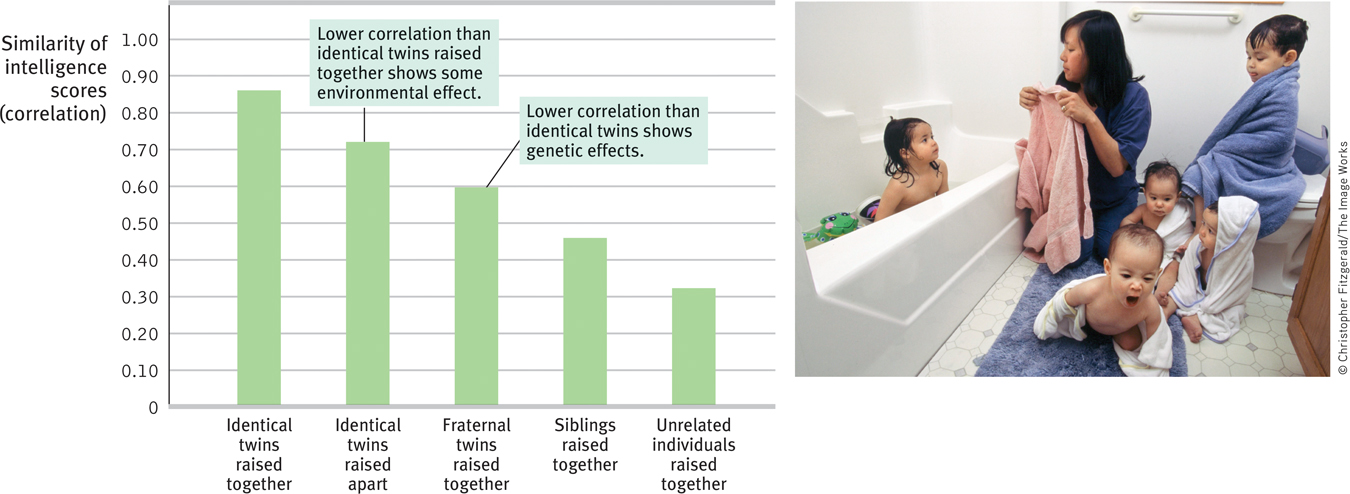
 Figure 10.11
Figure 10.11Intelligence: Nature and nurture The most genetically similar people have the most similar intelligence scores. Remember: 1.0 indicates a perfect correlation; zero indicates no correlation at all. (Data from McGue et al., 1993.)
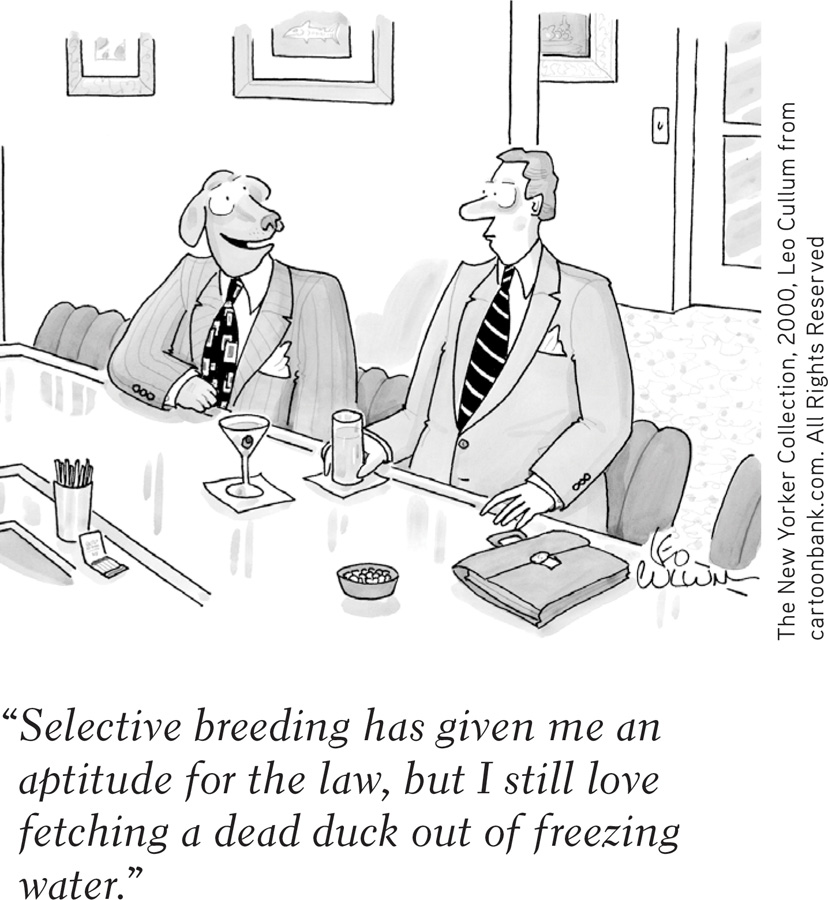
407
Seeking to disentangle genes and environment, researchers have also compared the intelligence test scores of adopted children with those of (a) their biological parents (the providers of their genes) and (b) their adoptive parents (the providers of their home environment). Over time, adopted children accumulate experience in their differing adoptive families. So would you expect the family-
If you would, behavior geneticists have a stunning surprise for you. Mental similarities between adopted children and their adoptive families wane with age, until the correlation approaches zero by adulthood (McGue et al., 1993). Genetic influences—
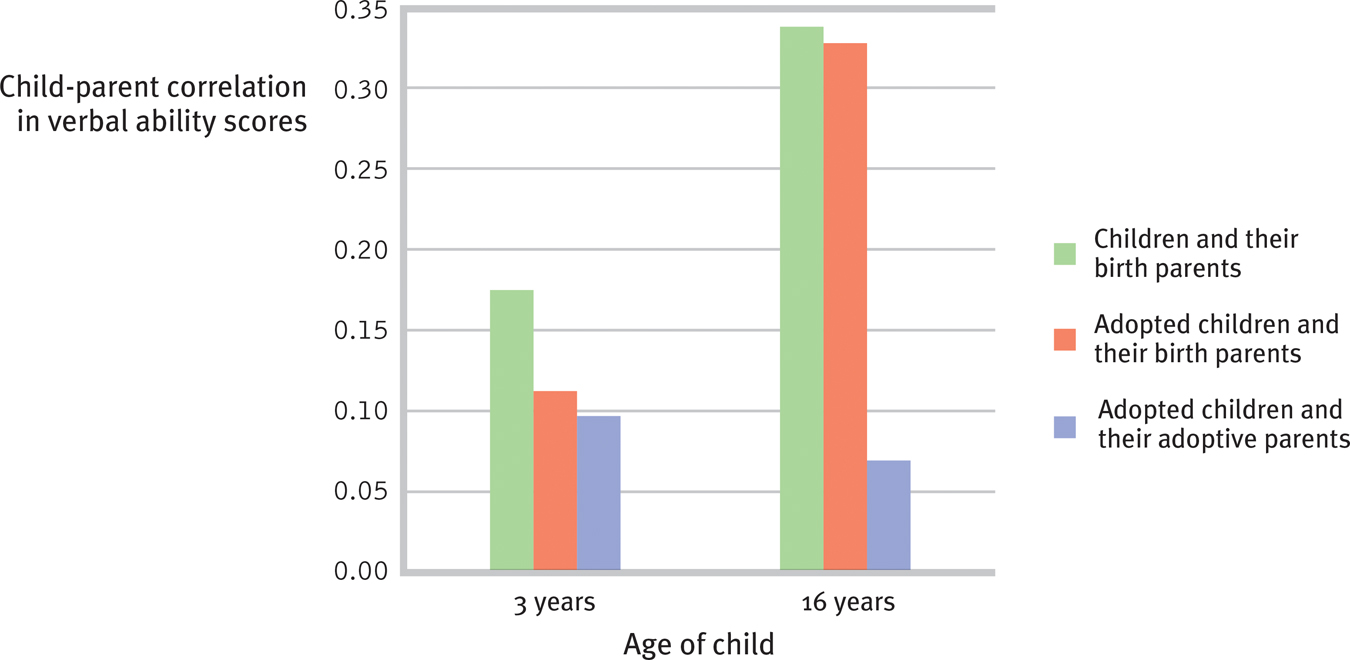
 Figure 10.12
Figure 10.12In verbal ability, who do adopted children resemble? As the years went by in their adoptive families, children’s verbal ability scores became more like their biological parents’ scores. (Data from Plomin & DeFries, 1998.)
408
RETRIEVAL PRACTICE
- A check on your understanding of heritability: If environments become more equal, the heritability of intelligence would
|
a. increase. |
b. decrease. |
c. be unchanged. |
a. (Heritability—
Environmental Influences
10-
Genes make a difference. Even if we were all raised in the same intellectually stimulating environment, we would have differing aptitudes. But life experiences also matter. Human environments are rarely as impoverished as the dark and barren cages inhabited by deprived rats that develop thinner-
Early Environmental Influences
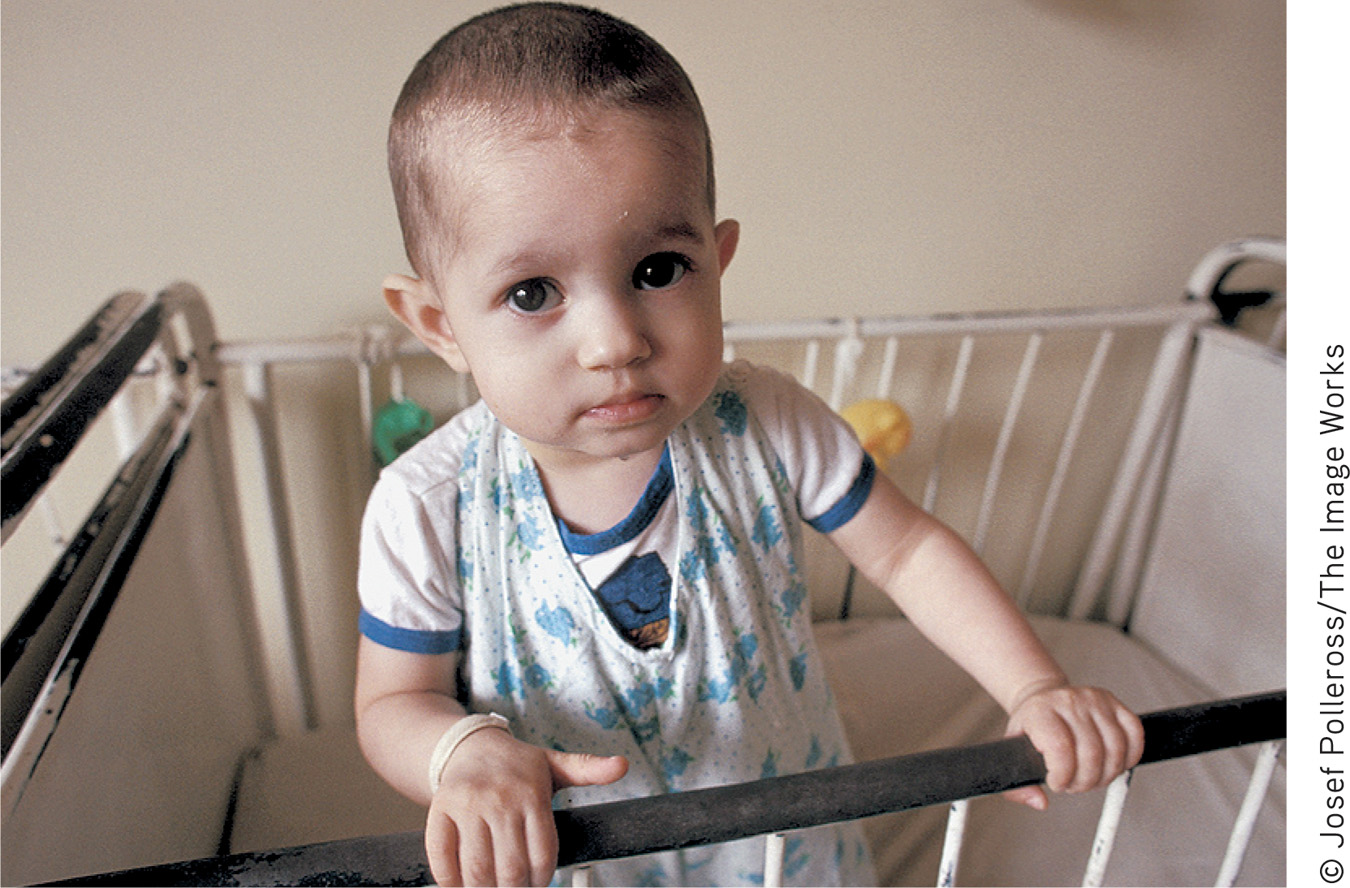
Nowhere is the intertwining of biology and experience more apparent than in the most hopeless human environments, such as J. McVicker Hunt (1982) observed in a destitute Iranian orphanage. The typical child Hunt observed there could not sit up unassisted at age 2 or walk at age 4. The little care the infants received was not in response to their crying, cooing, or other behaviors, so the children developed little sense of personal control over their environment. They were instead becoming passive “glum lumps.” Extreme deprivation was bludgeoning native intelligence—
Aware of both the dramatic effects of early experiences and the impact of early intervention, Hunt began a training program of tutored human enrichment for the Iranian caregivers, teaching them to play language-
Hunt’s findings are an extreme case of a more general finding: Poor environmental conditions can depress cognitive development. Schools with many poverty-
Poverty-
Malnutrition also plays a role. Relieve infant malnutrition with nutritional supplements, and poverty’s effect on physical and cognitive development lessens (Brown & Pollitt, 1996).
409
So, extreme conditions—
Schooling and Intelligence
Later in childhood, schooling is one intervention that pays intelligence score dividends. Schooling and intelligence interact, and both enhance later income (Ceci & Williams, 1997, 2009). Hunt was a strong believer in the ability of education to boost children’s chances for success by developing their cognitive and social skills. Indeed, his 1961 book, Intelligence and Experience, helped launch Project Head Start in 1965, a U.S. government-
Encouraging results come from intensive, high-
Genes and experience together weave the fabric of intelligence. (Epigenetics is one field that studies this nature–
These observations lend support to research by psychologist Carol Dweck (2006, 2012a,b). She reports that believing intelligence is changeable, not fixed, can foster a growth mind-
“It is our choices … that show what we truly are, far more than our abilities.”
Professor Dumbledore to Harry Potter in J. K. Rowling’s Harry Potter and the Chamber of Secrets, 1999
Real world studies confirm that ability + opportunity + motivation = success. High school students’ math proficiency and college students’ grades reflect their aptitude but also their self-
410
Group Differences in Intelligence Test Scores
If there were no group differences in aptitude scores, psychologists could politely debate hereditary and environmental influences in their ivory towers. But there are group differences. What are they? And what shall we make of them?
Gender Similarities and Differences
10-
In science, as in everyday life, differences, not similarities, excite interest. Compared with the anatomical and physiological similarities between men and women, our intelligence differences are minor. In that 1932 testing of all Scottish 11-
Yet, most people find differences more newsworthy. Girls outpace boys in spelling, verbal fluency, locating objects, detecting emotions, and sensitivity to touch, taste, and color (Halpern et al., 2007). Boys outperform girls in tests of spatial ability and complex math problems, though in math computation and overall math performance, boys and girls hardly differ (Else-
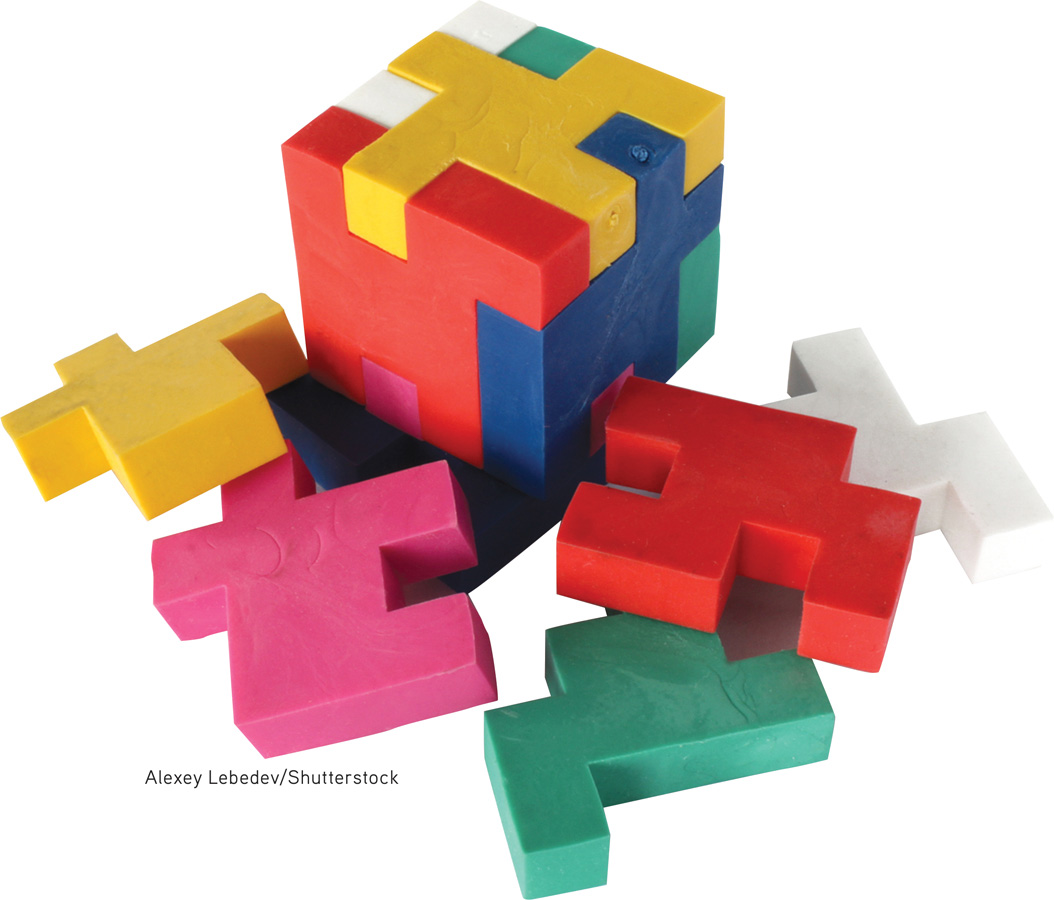
The most reliable male edge appears in spatial ability tests like the one shown in FIGURE 10.13 (Maeda & Yoon, 2013; Wei et al., 2012). The solution requires speedily rotating three-
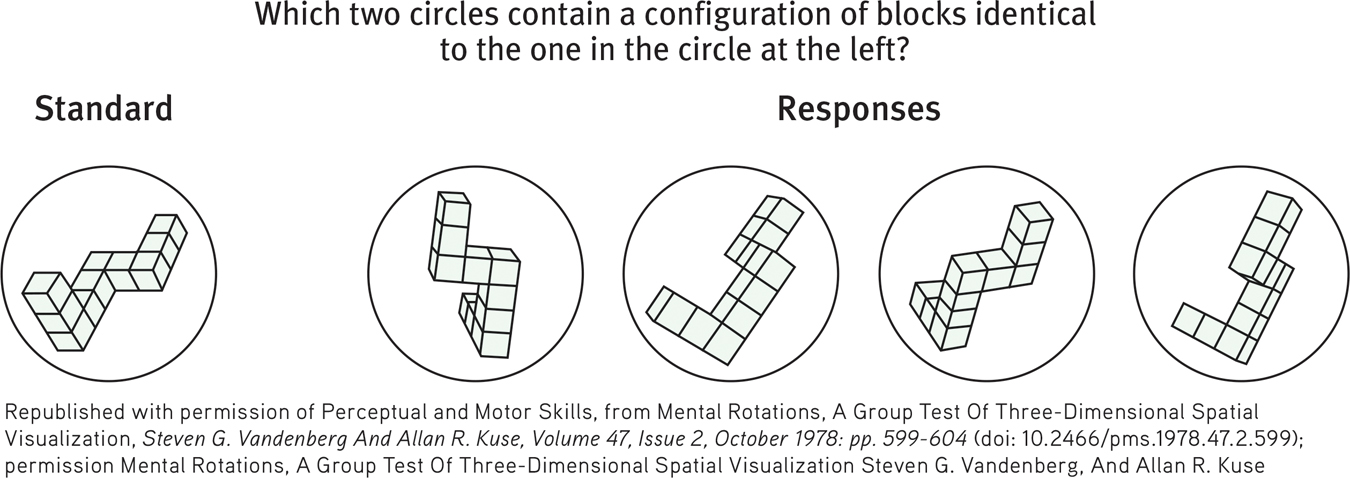
 Figure 10.13
Figure 10.13The mental rotation test
This is a test of spatial abilities. (From Vandenberg & Kuse, 1978.) See answer below.
ANSWER: The first and fourth alternatives.
But experience matters. One experiment found that playing action video games boosts spatial abilities, generally a male more than female pursuit (Eagan et al, 2013; Feng et al., 2007). Evolutionary psychologist Steven Pinker (2005) has argued that biology affects gender differences in life priorities (women’s greater interest in people versus men’s in money and things), in risk-
411

Other researchers remind us that social expectations and divergent opportunities shape boys’ and girls’ interests and abilities (Crawford et al., 1995; Eccles et al., 1990). In Asia and Russia, teen girls have outperformed boys in an international science exam; in North America and Britain, boys have scored higher (Fairfield, 2012). More gender-
Racial and Ethnic Similarities and Differences
10-
Fueling the group-
- Racial and ethnic groups differ in their average intelligence test scores.
- High-scoring people (and groups) are more likely to attain high levels of education and income.
There are many group differences in average intelligence test scores. New Zealanders of European descent outscore native Maori New Zealanders. Israeli Jews outscore Israeli Arabs. Most Japanese outscore most Burakumin, a stigmatized Japanese minority. Those who can hear have outscored those born deaf (Braden, 1994; Steele, 1990; Zeidner, 1990). And White Americans have outscored Black Americans. This Black-
We have seen that heredity contributes to individual differences in intelligence. But group differences in a heritable trait may be entirely environmental. Consider one of nature’s experiments: Allow some children to grow up hearing their culture’s dominant language, while others, born deaf, do not. Then give both groups an intelligence test rooted in the dominant language, and (no surprise) those with expertise in that language will score higher. Although individual performance differences may be substantially genetic, the group difference is not (FIGURE 10.14 below).
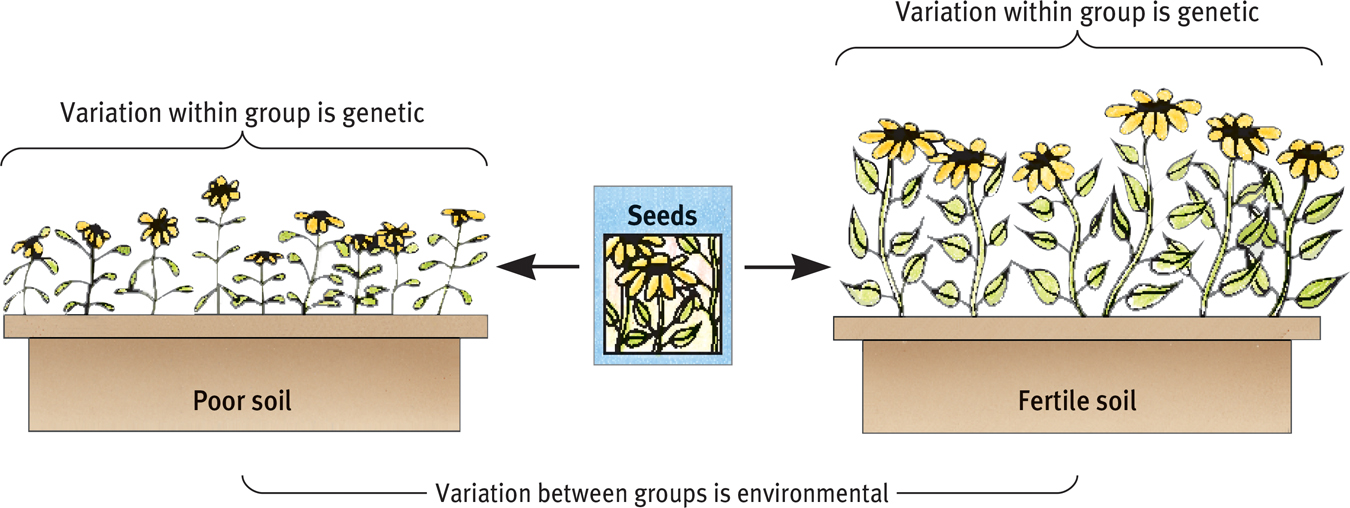
 Figure 10.14
Figure 10.14Group differences and environmental impact Even if the variation between members within a group reflects genetic differences, the average difference between groups may be wholly due to the environment. Imagine that seeds from the same mixture are sown in different soils. Although height differences within each window box of flowers will be genetic, the height difference between the two groups will be environmental. (Inspired by Lewontin, 1976.)

412
Might the racial gap be similarly environmental? Consider:
Genetics research reveals that under the skin, the races are remarkably alike. The average genetic difference between two Icelandic villagers or between two Kenyans greatly exceeds the group difference between Icelanders and Kenyans (Cavalli-
Race is not a neatly defined biological category. Many social scientists see race primarily as a social construction without well-

The intelligence test performance of today’s better-
When Blacks and Whites have or receive the same pertinent knowledge, they exhibit similar information-
Schools and culture matter. Countries whose economies create a large wealth gap between rich and poor tend also to have a large rich-
“Do not obtain your slaves from Britain, because they are so stupid and so utterly incapable of being taught.”
Cicero, 106–43 b.c.e.
In different eras, different ethnic groups have experienced golden ages—
413
RETRIEVAL PRACTICE
- In prosperous country X, everyone eats all they want. In country Y, the rich are well fed, but the semistarved poor are often thin. In which country will the heritability of body weight be greater?
The heritability (differences due to genes) of body weight will be greater in country X, where environmental differences in available nutrition are minimal.
The Question of Bias
10-
If one assumes that race is a meaningful concept, the debate over racial differences in intelligence divides into three camps (Hunt & Carlson, 2007):
- There are genetically disposed racial differences in intelligence.
- There are socially influenced racial differences in intelligence.
- There are racial differences in test scores, but the tests are inappropriate or biased.
We have considered group difference from the first and second perspectives. Let’s turn now to the third: Are intelligence tests biased? The answer depends on which of two very different definitions of bias we use.
Two Meanings of Bias
The scientific meaning of bias hinges on a test’s validity—
But we can also consider a test biased if it detects not only innate differences in intelligence but also performance differences caused by cultural experiences. This in fact happened to Eastern European immigrants in the early 1900s. Lacking the experience to answer questions about their new culture, many were classified as “feeble-
You may have read examples of intelligence test items that make assumptions (for example, that a cup goes with a saucer). Such items bias the test against those who do not use saucers. Could such questions explain cultural differences in test performance? In such cases, tests can be a vehicle for discrimination, consigning potentially capable children (some of whom may have a different native language) to dead-
Defenders of the existing aptitude tests have noted that racial group differences persist on nonverbal items, such as counting digits backward (Jensen, 1983, 1998). Moreover, they add, blaming the test for a group’s lower scores is like blaming a messenger for bad news. Why blame the tests for exposing unequal experiences and opportunities? If, because of malnutrition, people were to suffer stunted growth, would you blame the measuring stick that reveals it? If unequal past experiences predict unequal future achievements, a valid aptitude test will detect such inequalities.
414
So, test-
RETRIEVAL PRACTICE
- What is the difference between a test that is biased culturally and a test that is biased in terms of its validity?
A test may be culturally biased if higher scores are achieved by those with certain cultural experiences. That same test may not be biased in terms of validity if it predicts what it is supposed to predict. For example, the SAT may be culturally biased in favor of those with experience in the U.S. school system, but it does still accurately predict U.S. college success.
stereotype threat a self-confirming concern that one will be evaluated based on a negative stereotype.
Test-
When Steven Spencer and his colleagues (1997) gave a difficult math test to equally capable men and women, women did not do as well—
“Math class is tough!”
“Teen talk” talking Barbie doll (introduced July 1992, recalled October 1992)
Critics argue that stereotype threat does not fully account for Black-

Steele (1995, 2010) concludes that telling students they probably won’t succeed (as is sometimes implied by remedial “minority support” programs) functions as a stereotype that can erode performance. Over time, such students may detach their self-
415
One experiment randomly assigned some African-
***
What, then, can we realistically conclude about aptitude tests and bias? The tests are not biased in the scientific sense of failing to make valid statistical predictions for different groups. But they are indeed biased (appropriately so, some would say) in one sense—
“Almost all the joyful things of life are outside the measure of IQ tests.”
Madeleine L’Engle, A Circle of Quiet, 1972
Perhaps, then, our goals for tests of mental abilities should be threefold. First, we should realize the benefits that intelligence testing pioneer Alfred Binet foresaw—
The point to remember: There are many ways of being successful; our differences are variations of human adaptability. Life’s great achievements result not only from “can do” abilities (and fair opportunity) but also from “will do” motivation. Competence + Diligence → Accomplishment.
“[Einstein] showed that genius equals brains plus tenacity squared.”
Walter Isaacson, “Einstein’s Final Quest,” 2009
RETRIEVAL PRACTICE
- What psychological principle helps explain why women tend to perform more poorly when they believe their online chess opponent is male?
stereotype threat
416
REVIEW: Genetic and Environmental Influences on Intelligence

|
REVIEW | Genetic and Environmental Influences on Intelligence |
LEARNING OBJECTIVES
RETRIEVAL PRACTICE Take a moment to answer each of these Learning Objective Questions (repeated here from within this section). Then click the 'show answer' button to check your answers. Research suggests that trying to answer these questions on your own will improve your long-term retention (McDaniel et al., 2009).
10-
Studies of twins, family members, and adoptees indicate a significant hereditary contribution to intelligence scores. Intelligence seems to be polygenetic, and researchers are searching for genes that exert an influence. Heritability is the proportion of variation among individuals that can be attributed to genes.
10-
Studies of twins, family members, and adoptees also provide evidence of environmental influences. Test scores of identical twins raised apart are slightly less similar (though still very highly correlated) than the scores of identical twins raised together. Studies of children raised in extremely impoverished environments with minimal social interaction indicate that life experiences can significantly influence intelligence test performance. No evidence supports the idea that normal, healthy children can be molded into geniuses by growing up in an exceptionally enriched environment.
10-
Males and females tend to have the same average intelligence test scores, but they differ in some specific abilities. Girls are better spellers, more verbally fluent, better at locating objects, better at detecting emotions, and more sensitive to touch, taste, and color. Boys outperform girls at spatial ability and related mathematics, though in math computation and overall math performance, boys and girls hardly differ. Boys also outnumber girls at the low and high extremes of mental abilities. Evolutionary and cultural explanations have been proposed for these gender differences.
10-
Racial and ethnic groups differ in their average intelligence test scores. The evidence suggests that environmental differences are responsible for these group differences.
10-
Aptitude tests aim to predict how well a test-taker will perform in a given situation. So they are necessarily “biased” in the sense that they are sensitive to performance differences caused by cultural experience. By “inappropriately biased,” psychologists mean that a test predicts less accurately for one group than for another. In this sense, most experts consider the major aptitude tests unbiased. Stereotype threat, a self-confirming concern that one will be evaluated based on a negative stereotype, affects performance on all kinds of tests.
TERMS AND CONCEPTS TO REMEMBER
RETRIEVAL PRACTICE Match each of the terms on the left with its definition on the right. Click on the term first and then click on the matching definition. As you match them correctly they will move to the bottom of the activity.
Question
heritability stereotype threat | the proportion of variation among individuals that we can attribute to genes. The heritability of a trait may vary, depending on the range of populations and environments studied. a self-confirming concern that one will be evaluated based on a negative stereotype. |
Use  to create your personalized study plan, which will direct you to the resources that will help you most in
to create your personalized study plan, which will direct you to the resources that will help you most in  .
.
TEST
YOUR-
SELF INTELLIGENCE
Test yourself repeatedly throughout your studies. This will not only help you figure out what you know and don’t know; the testing itself will help you learn and remember the information more effectively thanks to the testing effect.
 What Is Intelligence?
What Is Intelligence?
Question
1. Charles Spearman suggested we have one underlying success across a variety of intellectual abilities.
Question
2. The existence of savant syndrome seems to support
| A. |
| B. |
| C. |
| D. |
Question
You must enter the answers in alphabetical order.
3. Sternberg’s three types of intelligence are , , and .
Question
4. Emotionally intelligent people tend to
| A. |
| B. |
| C. |
| D. |
 Assessing Intelligence
Assessing Intelligence
Question
5. The IQ of a 6-year-old with a measured mental age of 9 would be
| A. |
| B. |
| C. |
| D. |
Question
6. The Wechsler Adult Intelligence Scale (WAIS) is best able to tell us
| A. |
| B. |
| C. |
| D. |
Question
7. The Stanford-Binet, the Wechsler Adult Intelligence Scale, and the Wechsler Intelligence Scale for Children yield consistent results, for example on retesting. In other words, these tests have high .
417
 The Dynamics of Intelligence
The Dynamics of Intelligence
Question
8. Use the concepts of crystallized and fluid intelligence to explain why writers tend to produce their most creative work later in life, and scientists may hit their peak much earlier.
Writers’ work relies more on crystallized intelligence, or accumulated knowledge, which increases with age. For top performance, scientists doing research may need more fluid intelligence (speedy and abstract reasoning), which tends to decrease with age.
Question
9. More intelligent children and adults tend to live healthier and longer lives. Which of the following is NOT a possible reason for this phenomenon?
| A. |
| B. |
| C. |
| D. |
 Genetic and Environmental Influences on Intelligence
Genetic and Environmental Influences on Intelligence
Question
10. The strongest support for heredity’s influence on intelligence is the finding that
| A. |
| B. |
| C. |
| D. |
Question
11. To say that the heritability of intelligence is about 50 percent means that 50 percent of
| A. |
| B. |
| C. |
| D. |
Question
12. The environmental influence that has the clearest, most profound effect on intellectual development is
| A. |
| B. |
| C. |
| D. |
Question
13.
can lead to poor performance on tests by undermining test-